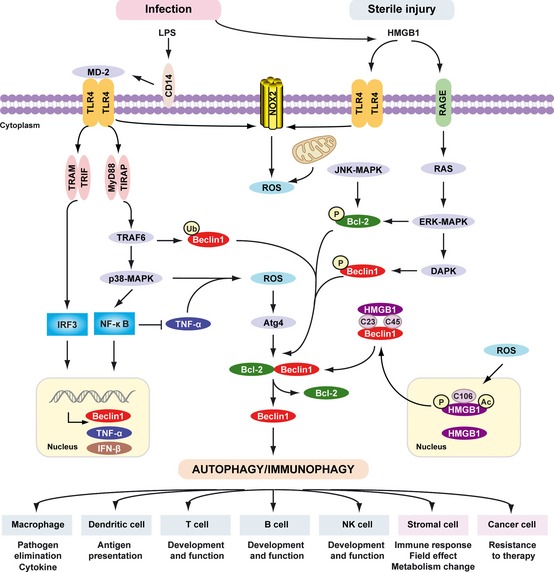Figure 6.

Signaling pathways triggered by LPS and HMGB 1 in autophagy/immunophagy. The inflammatory response, including the recruitment and migration of immune cells to the site of infection and release of cytokines, is mediated by lipopolysaccharide (LPS). LPS bound to LPS‐binding protein (LBP) is presented to CD14. CD14 maneuvers the LPS‐LBP complex to TLR4, and LPS, in combination with accessory molecule MD2, activates TLR4 signaling. LPS induces activation of the tumor necrosis factor receptor (TNFR)‐associated factor 6 (TRAF6)‐p38 MAPK pathway and induces the expression of TNF‐α and Beclin 1 by NF‐κB. NF‐κB inhibits TNF‐α‐induced autophagy. Multiple means to promote ROS production converge on the mitochondria or alternatively, NADPH oxidases such as NOX2 and NOX4. These in turn results in activation of autophagy through Atg4 activation, ultimately reducing the binding of Beclin 1 to Bcl‐2. TRIF‐dependent and/or MyD88‐dependent TLR4 pathway is required for LPS‐induced autophagy in macrophages. Moreover, TRAF6‐mediated ubiquitination of Beclin1 amplifies TLR4‐induced autophagy. HMGB1 links sterile injury and infection‐induced immunity. Stimuli that enhance reactive oxygen species promote cytosolic translocation of HMGB1 and thereby enhance autophagic flux. HMGB1 directly interacts with Beclin1, displacing Bcl‐2 requiring the cysteines at positions C23 and C45 within HMGB1. The HMGB1/RAGE interaction activates parallel signaling pathways, including ERK1/2 and NF‐ κB activation. Mitogen‐activated protein kinases (MAPKs), such as JNK1 and ERK1/2, also phosphorylate Bcl‐2 driving subsequent dissociation of the Beclin 1‐Bcl‐2 complex. Notably, DAPK phosphorylates Beclin 1, promoting the dissociation of Beclin 1 from Bcl‐2 like proteins, which in turn induces autophagy. Activation of phagocytic NADPH oxidase (NOX2) by HMGB1 requires TLR4 expression; the activation of other NADPH oxidases and interaction with TLRs is less clear. Thus PAMPs (LPS) and DAMPs (HMGB1) drive autophagy/immunophagy, regulating immune, stromal, and tumor cell functions.
